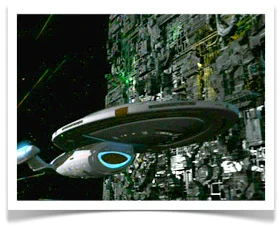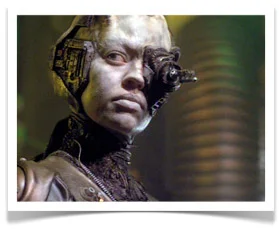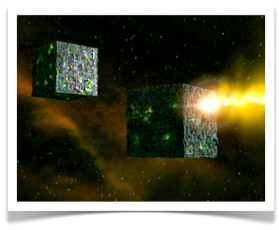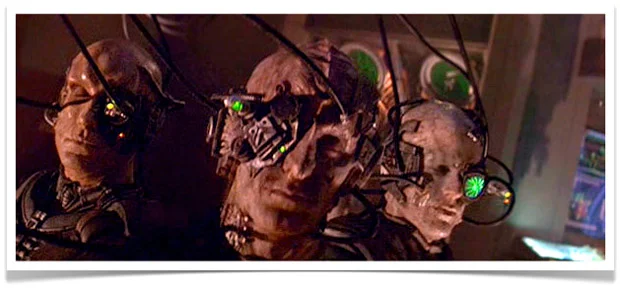An audio version of this Captain’s Log is available.
by Christopher Jones
“We are the Borg. Lower your shields and surrender your episodes. We will add your series distinctiveness to our own. Your show will adapt to service us. Resistance is futile.”
If there’s one distinct impression that Star Trek: Voyager left on the audience, it’s that perhaps the series should have been called Star Trek: Borg. But is this really true? Was Voyager really assimilated by the Borg?
I myself have said on a number of occasions that this is the case. However, when I really stop and think about how the Borg were used on the show, and the episodes in which they appeared, I realize this may not be the case.
So let’s take a look at the Borg on Voyager and find out just to what extent their nanoprobes infiltrated this chapter in the Star Trek saga.
Distant Origin
It was only fitting, and indeed expected, that Voyager would at some point encounter the Borg. After all, we learned in The Next Generation that the Borg originated in the Delta Quadrant. So it should come as no surprise to the viewer that these powerful and popular villains from TNG became a recurring theme on a show about the Delta Quadrant.
The problem is that the Borg became so much a part of Voyager’s image that at times they overwhelmed the show. Certainly the inclusion of Seven of Nine as a member of the crew meant that there would be a permanent presence of Borg elements. But it went further than that, and the Borg began appearing every time the writers needed a big story.
Or so it seemed. Perception is as important as reality, and often what we perceive to be true is not. So just how often were the Borg actually used on Voyager?
Persistence of Vision
They say you only get one chance to make a first impression; and the Borg make a hell of one. From the moment they first appeared in the Next Generation episode “Q Who?” the presence of the Borg has been one of the strongest things in all of Star Trek. When you think of The Next Generation, you think of the Borg. But the Borg only appeared in six of the 176 episodes and four movies produced for TNG. That’s quite an impression.
A similar effect took place on Voyager, with the Borg appearing in only 22 of the show’s 168 episodes yet leaving many fans feeling that the show is all about the Borg. This pales in comparison to the Klingons who appeared 31 times in The Next Generation and 49 times in Deep Space Nine, yet we think of neither of these as Klingon series. So perhaps the real question isn’t the frequency with which the Borg are used but rather how they are used.
Time and Again
The first appearance of the Borg on Voyager came in the third-season episode “Blood Fever” in the form of a corpse. Then a couple of episodes later in “Unity” Voyager encounters a Borg cube adrift in space. Showing their hand early, the writers center this story around a group of aliens who were once Borg but are adapting to life separated from the Collective.
On the one hand this was promising because it appeared that on the Borg’s home ground we would see a new exploration of this alien race. Just as The Next Generation had done for the Klingons and Deep Space Nine had done for the Cardassians, Voyager had the opportunity to bring depth to the Borg and explore their culture.
So indeed things looked promising. At the same time, however, it was also the start of something else Voyager did to the Borg, which was to defang them and make them weak.
Dragon’s Teeth
In the Season 3 finale “Scorpion” the Borg came back in force with one of the great opening sequences in Star Trek. “Blood Fever” and “Unity” had teased us and it now appeared that fans were going to get something that they really wanted—the first good look at the Borg since the film First Contact.
But then the writers immediately took the next step in the weakening of the Borg, introducing a foe so powerful that the Collective was virtually defenseless against this enemy. Species 8472 was a great concept that sadly got relegated to nothing more than a plot device to set up a bond between Voyager and the Borg. But that’s for another discussion.
The point is that the Borg couldn’t simply show up over and over doing the “Best of Both Worlds” we’re-going-to-assimilate-you routine and work as a viable part of Voyager. So their frequent appearance forced the Borg into situations in which they had to be inferior to our heroes.
The Gift
“Scorpion” did more for Voyager than just bring back a popular enemy from Star Trek’s past. It also gave the show a gift in the form of Seven of Nine. The addition of a Borg crew member gave the series a dynamic that had been missing in the first three seasons. In this respect the encounter with the Borg worked both as an exciting cliffhanger and as a set-up for a critical transition in the series.
As important as this moment was in the development of Voyager, it was also a dangerous one because it provided the writers with a crutch upon which to lean for the remainder of the series when they were short on original ideas.
And thus as we peer over the wall of “Scorpion” we see the landscape extending off into the distance littered with episodes featuring Borg. Some of these stories are great and develop the character of Seven while delving into the kind of internal examinations that have always made Star Trek great. Then others appear to have been formulated simply for ratings.
Survival Instinct
One of the problems with Voyager is that it was on a network. Unlike The Next Generation and Deep Space Nine, Voyager lacked the freedom of syndication and was under studio pressure to meet ratings expectations. This brought us stories like “Dark Frontier,” a two-hour TV movie designed to pull in viewers for the network. That’s not to say that “Dark Frontier” is a bad story, but it is certainly a case of dipping into the well of the tried-and-true instead of charting new territory as a series.
During the final two seasons of Voyager, at the most key moments, the writers turned to the Borg. The sixth season finale, “Unimatrix Zero,” brought in the Borg to assimilate not only Captain Janeway but also Tuvok and B’Elanna a la “Best of Both Worlds” on steroids. And when it came time to wrap up the entire series it was once again the Borg who came to the rescue.
In the case of the series finale, “Endgame,” the use of the Borg was appropriate given the extent to which they had already been used in the series. However Voyager was at its best when it told stories about the crew and did not rely on always-reliable standbys like the Borg. So it sometimes felt as if the writers’ survival instinct was kicking in and the Borg provided an easy path to ratings and were thus the safer choice.
Before and After
At the end of the day the question to ask is whether Voyager was a better series before the introduction of the Borg or after. In response to this I have to say after. While I may not approve of the way the Borg were used in specific instances, nor the way they were weakened to the point of seeming final defeat at the hands of Janeway in “Endgame,” they did bring us Seven of Nine.
The arrival of Seven of Nine was a turning point for Voyager as the addition of another strong personality as a counterpoint to Janeway enriched the stories over the final four seasons. Chakotay also had a strong personality but he had to work together with Janeway in the command structure and so an outside view was needed.
The Borg flavor that came along with Seven—both in terms of character and visuals—gave Voyager a unique identity. I only wish that the Collective itself, and Voyager’s encounters with it, had played a smaller role in the series.
Coda
There are many specifics that we could discuss about the Borg on Voyager, but let’s return to our original question: Did the Borg assimilate Star Trek: Voyager?
When taken as a whole the answer is no. The Borg did not appear on Voyager as frequently as perception would suggest. While 22 episodes is a lot, it means that over the final four seasons three-quarters of the stories did not involve the Borg. (And even amongst those 22, not all centered around the Borg.)
To be more accurate, however, it must be pointed out that much of the perception is due to the fact that a former Borg became part of the crew. And as a result Borg imagery and Borg technology became a constant part of life aboard the Starship Voyager. Additional moves such as the stretch of episodes in which Borg children, separated from the Collective, took up residence aboard Voyager only served to reinforce this perception that the series should have been called Star Trek: Borg.
But in the end there are plenty of non-Borg stories that help Voyager stand on its own, free from assimilation.






